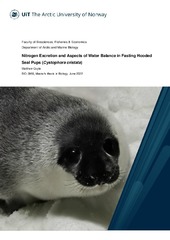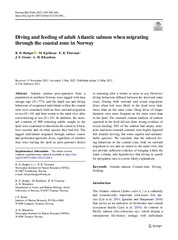Institutt for arktisk og marin biologi: Nye registreringer
Viser treff 601-620 av 2084
-
Nitrogen Excretion and Aspects of Water Balance in Fasting Hooded Seal Pups (Cystophora cristata)
(Master thesis; Mastergradsoppgave, 2022-06-10)The post-weaning fast of hooded seal pups (Cystophora cristata) is not well understood. What energy sources are being used? How is water balance maintained? How are these mechanisms balanced with thermoregulation? This study aims to answer some questions on the physiological mechanisms in place to assist an Arctic seal pup in the early stages of their life with no source of food or freshwater. ... -
Under-ice plankton abundance and lipid dynamics in a subarctic lake.
(Master thesis; Mastergradsoppgave, 2022-05-16)Shortening winters and changing ice and snow cover conditions are examples of the many shifts expected in subarctic lakes due to climate change. Well-documented changes in ice and snow cover conditions highlight the need to understand under-ice ecosystems and the consequences a changing climate brings to the freshwater biota. This study investigated the impact of under-ice environmental conditions ... -
Are Hooded seals (Cystophora cristata) endowed with mechanisms for non-shivering thermogenesis within the skeletal muscle?
(Master thesis; Mastergradsoppgave, 2022-06-15)Hooded seals (Cystophora cristata) are marine mammals and are characterised as an “Arctic seal” species due to their close association to the pack ice. Their relationship with the ice and water creates challenges in maintaining an internal body temperature of ~37°C. In homeothermic animals, like the hooded seal, shivering is used for thermogenesis, however this can rapidly fatigue skeletal muscle. ... -
Diving and feeding of adult Atlantic salmon when migrating through the coastal zone in Norway
(Journal article; Tidsskriftartikkel; Peer reviewed, 2022-05-23)Atlantic salmon post-spawners from a population in northern Norway were tagged with data storage tags (N = 773), and the depth use and diving behaviour of recaptured individuals within the coastal zone were examined, both on their outward migration to sea (N = 44) and their return to the natal river after overwintering at sea (N = 34). In addition, the stomach contents of 909 returning adults caught ... -
Experiences from 40 years of muskox (Ovibos moschatus) farming in Norway
(Journal article; Tidsskriftartikkel; Peer reviewed, 2011-04-01)Experiences from the management of a semi-domesticated herd of muskoxen, mostly on an island outside Tromsø (~70º N; 19º E), over a period of 40 years have been collected, and data on husbandry practices, reproduction, diseases and longevity are presented and discussed. -
Time series data for Canadian arctic vertebrates: IPY contributions to science, management, and policy
(Journal article; Tidsskriftartikkel; Peer reviewed, 2012-05-22)Long-term data are critically important to science, management, and policy formation. Here we describe a number of data collections from arctic Canada that monitor vertebrate population trends of freshwater and marine fish, marine birds, marine and terrestrial mammals. These time series data cover the last ca. 30 years and capture a period from the onset of global changes affecting the Arctic up to ... -
Is Glacial Meltwater a Secondary Source of Legacy Contaminants to Arctic Coastal Food Webs?
(Journal article; Tidsskriftartikkel; Peer reviewed, 2022-04-26)Climate change-driven increases in air and sea temperatures are rapidly thawing the Arctic cryosphere with potential for remobilization and accumulation of legacy persistent organic pollutants (POPs) in adjacent coastal food webs. Here, we present concentrations of selected POPs in zooplankton (spatially and seasonally), as well as zoobenthos and sculpin (spatially) from Isfjorden, Svalbard. ... -
Land-cover, climate and fjord morphology drive differences in organic matter and nutrient dynamics in two contrasting northern river-fjord systems
(Journal article; Tidsskriftartikkel; Peer reviewed, 2022-03-31)Climate and land-use changes are leading to impacts on individual ecosystems as well as shifts in transfer dynamics between interconnected systems. At the land-ocean interface, changes in riverine inputs of organic matter (OM) and nutrients have the potential to lead to shifts in coastal carbon and nutrient cycling with consequences for ecosystem structure and function. In this study, we assess OM ... -
Merging indigenous and scientific knowledge links climate with the growth of a large migratory caribou population
(Journal article; Tidsskriftartikkel; Peer reviewed, 2020-01-08)1. Climate change in the Arctic is two to three times faster than anywhere else in the world. It is therefore crucial to understand the effects of weather on keystone arctic species, particularly those such as caribou (Rangifer tarandus) that sustain northern communities. Bridging long-term scientific and indigenous knowledge offers a promising path to achieve this goal, as both types of knowledge ... -
Uncovering the secrets they keep – the role of parasites in food web ecology
(Master thesis; Mastergradsoppgave, 2022-06-01)Interactions involving parasites often account for large proportions of links within aquatic food webs, yet few studies integrate parasites into their food web analyses. This analysis compares three sets of highly resolved food webs that differ in taxa composition, space, and time for a subarctic lake system. Key topological food web metrics, including connectance, linkage density, and mean generality ... -
Molecular study of digenean diversity in aquatic organisms in northern Norway, with a focus on the seasonality of Crepidostomum [Braun, 1900]
(Master thesis; Mastergradsoppgave, 2022-06-07)This study aimed to elucidate cryptic trematode diversity across multiple life stages in aquatic organisms. I collected samples from first intermediate hosts (bivalves), second intermediate hosts (amphipods and insect nymphs), and definitive hosts (fish), and identified them by use of molecular methods. Phylograms based on molecular markers from 28S and COI genes were used to identify nine species ... -
The structure of nasal conchae in Svalbard rock ptarmigan (Lagopus muta hyperborea) with comparisons to three other Galliform birds
(Master thesis; Mastergradsoppgave, 2022-05-27)Birds are endothermic homeotherms that regulate internal metabolic heat production to keep a stable body core temperature. Lung ventilation, which is required to obtain oxygen for metabolism, is potentially a large source for heat and water loss. In a polar habitat with low year-round temperatures and scarcity of food in the winter, conservation of heat and water is crucial for survival of the ... -
Validating the Tritiated Water Method in Adult Harp Seal
(Master thesis; Mastergradsoppgave, 2022-05-16)As one of the top predators in the northeast Atlantic, and most numerous, the harp seal (Pagophilus groenlandicus), has a significant role in the higher trophic levels in the ecosystem. Their condition can be an indicator of changes in prey availability, competition with other species or even climate. It can also be a useful tool in predicting the pup production and breeding success. The ... -
Dive behaviour and respiration rates of humpback whales (Megaptera Novaeangliae) during foraging off Northern Norway, with implications for metabolic rate estimates
(Master thesis; Mastergradsoppgave, 2022-05-16)Knowing the metabolic rate of marine mammals is often important as baseline knowledge of their biology and physiology, e.g., to allow ecosystem assessments and estimation of their resource needs and use, and prey requirements. However, our current knowledge of energetics of large cetaceans is limited compared to many smaller cetaceans. Determining the energy expenditure of large free-ranging whales ... -
Marine growth of introduced pink salmon (Oncorhynchus gorbuscha) caught in northern and central Norway
(Master thesis; Mastergradsoppgave, 2022-05-16)The introduction of pink salmon in the White Sea area during the second half of the 20th century has resulted in the establishment of a self-sustaining population of pink salmon in rivers draining to the Barents Sea and North Atlantic Ocean. The size and abundance of pink salmon is dependent on survival during the marine phase, where they acquire more than 95% of their body weight. Investigating ... -
Exploring the potential of an online platform for citizen science-based ecological monitoring of plant- and wildlife on the high-Arctic Archipelago Svalbard
(Master thesis; Mastergradsoppgave, 2022-05-16)Citizen science is increasingly used to include in ecological monitoring over the past three decades. Web-based applications or smart phones enable citizens to record observations or experiences at larger temporal and spatial scale and provide opportunities for a larger number of citizens to participate in mapping observations. Citizen science can also be used to record, or map observed and experienced ... -
Environmental drivers of population-level variation in the migratory and diving ontogeny of an Arctic top predator
(Journal article; Tidsskriftartikkel; Peer reviewed, 2022-03-02)The development of migratory strategies that enable juveniles to survive to sexual maturity is critical for species that exploit seasonal niches. For animals that forage via breath-hold diving, this requires a combination of both physiological and foraging skill development. Here, we assess how migratory and dive behaviour develop over the first year of life for a migratory Arctic top predator, the ... -
Mid-summer vertical behavior of a high-latitude oceanic zooplankton community
(Journal article; Tidsskriftartikkel; Peer reviewed, 2022-03-18)Vertical behavior, such as diel vertical migration (DVM) and swarming are widespread among zooplankton. At higher latitudes, synchronized DVM is mostly absent during summer and predominantly herbivorous copepods tend to form large near-surface swarms. This behavior is risky because it can make them vulnerable to visual predators. Here, we used ca. 12 days of mid-summer (28 June to 10 July 2018) ... -
Temporal Trends of Organochlorine and Perfluorinated Contaminants in a Terrestrial Raptor in Northern Europe Over 34 years (1986–2019)
(Journal article; Tidsskriftartikkel; Peer reviewed, 2022-03-21)Fourteen legacy organochlorine (OC) contaminants and 12 perfluoroalkyl substances (PFASs) were measured in eggs of tawny owls (Strix alueco) in central Norway (1986–2019). We expected OCs to have reached stable equilibrium levels due to bans, and that recent phase-out of some PFASs would have slowed the increase of these compounds. ∑OC comprised on average approximately 92% of the measured compounds, ... -
Congruent responses to weather variability in high arctic herbivores
(Journal article; Tidsskriftartikkel; Peer reviewed, 2012-09-26)Assessing the role of weather in the dynamics of wildlife populations is a pressing task in the face of rapid environmental change. Rodents and ruminants are abundant herbivore species in most Arctic ecosystems, many of which are experiencing particularly rapid climate change. Their different life-history characteristics, with the exception of their trophic position, suggest that they should show ...


 English
English norsk
norsk


















